Published July 2022
The Ultimate Guide To Automotive Leather
By Emma Vander Ploeg, United Automotive Interiors
What does it mean when a manufacturer says your vehicle has leather seats? What’s the difference between genuine leather, vegan leather, leatherette and vinyl? How do I care for my seats to extend their lifespan? As vehicle owners and buyers, these are all important questions we have and researching them can get confusing fast!
If you’re looking for an answer to these questions this is the guide for you! My intent with this guide is to make it easier for anyone looking to buy a vehicle, needing a seat repair, or interested in a aftermarket cloth-to-leather conversion. With this guide I’ll take you through the benefits and difficulties of leather seats, maintenance needs, and all the options available for an aftermarket conversion.
Table Of Contents
Leather, What is it?
The word leather can mean many different things in the automotive industry. The prolific use of terms such as ‘leather accented’ and ‘leatherette’ can confuse consumers into believing that they’re buying a vehicle with leather seats when in reality there’s little real, from-a-cow, leather present.
Here’s a quick rundown of some popular terms and what they really mean:
- Leather: When used honestly, this means that something is being made of treated cattle hide. Often used as a catch-all for the below terms or a mixture of genuine and fake leather. When used as a catch-all in this article you will see it as the following: ‘leather’
- Genuine Leather: A term used when there is at least 20% leather present in a product. Genuine leather is composed of multiple bonded layers of low-quality leather, think of it as the plywood or particle board version of leather.
- Top Grain Leather: the leather found in most products, including automotive leather. It’s made by splitting a hide, reducing any imperfections, and then stamping it with a new grain pattern.
- Full Grain Leather: The highest possible quality of the leather (depending on use). Has the original grain, including all imperfections present. Full-grain is typically not used for automotive purposes.
- Automotive Leather: Typically made of top grain leather specially treated to withstand the wear and tear of automotive use.
- Leather Accent: Small to none amounts of real leather present.
- Vegan Leather: Either an automotive vinyl (plastic) or in some cases made from plant or other renewable/biodegradable materials. In most cases, vegan leather isn’t more environmentally friendly because plastic sticks around much longer than leather, but it can reduce the use of the cattle industry.
- Leatherette, Synthetic Leather, Imitation Leather… See Below.
- Vinyl: The most honest term for any imitation leather made from plastic. Automotive vinyl is specifically made to withstand the wear and tear of regular vehicle use and Marine Vinyl is made to withstand marine usage.
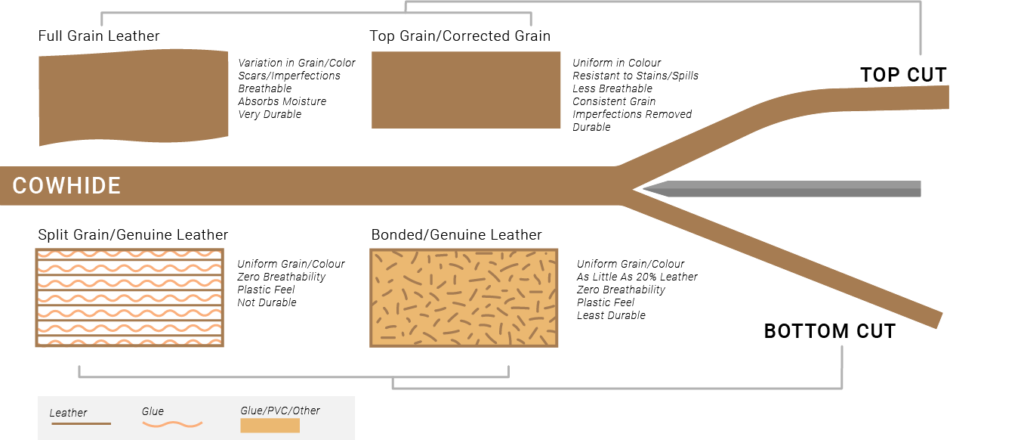
Completing hundreds of seat repairs from all makes and models each year has taught us much about which vehicles have which kinds of ‘leather’ and what to watch out for. A common one is Toyota’s heavy use of vinyl. Toyota previously described their interiors as ‘leather accented’. More recently, they have branded their interiors as ‘Softex’ faux leather, the benefits of which seem to be primarily argued for by Toyota branded websites. Other companies, such as Mercedes Benz, do a better job of marketing and installing leather, though their designs also come with some flaws that have resulted in an unusually high need for repairs.
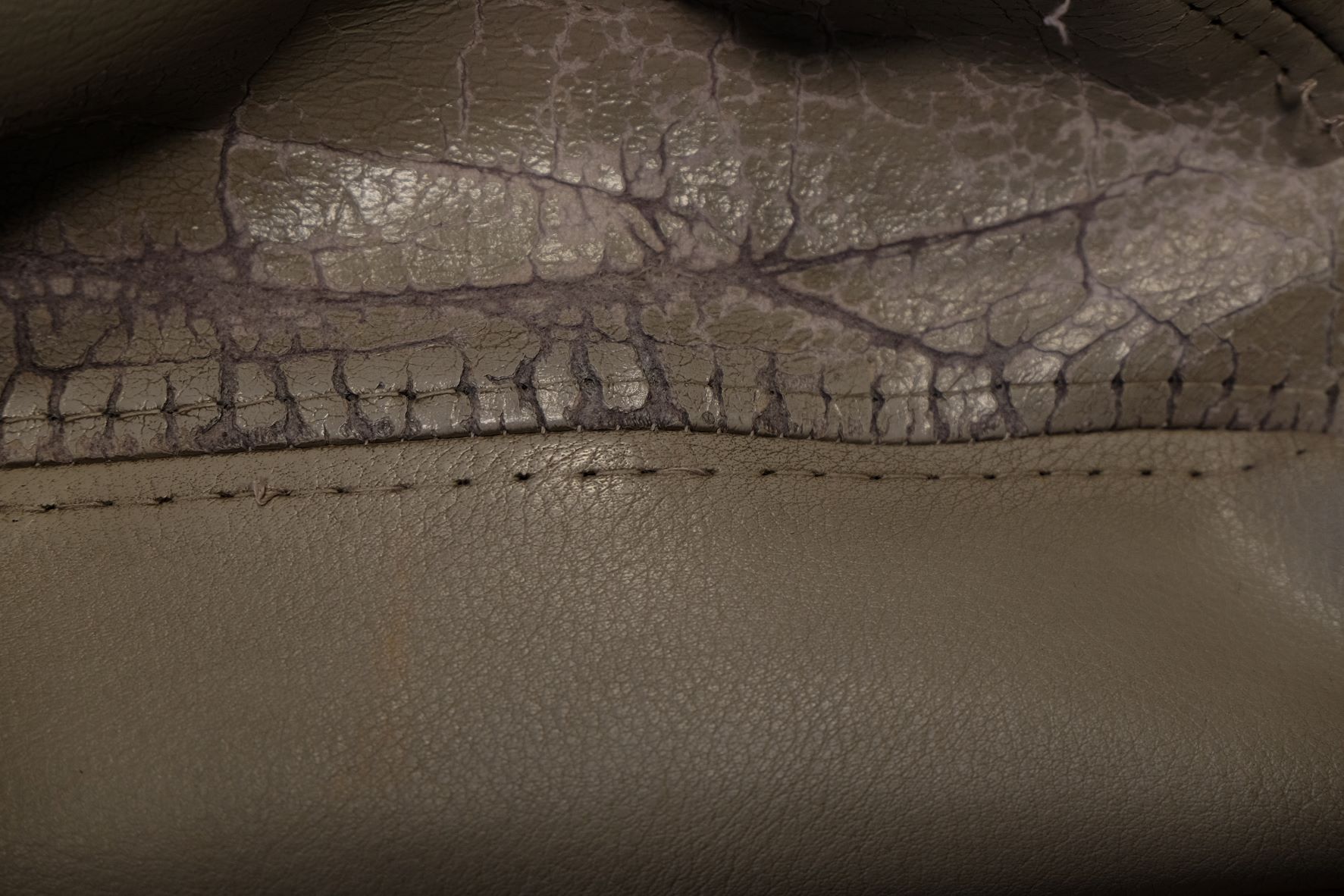
<<< Pictured: Aged upholstery we pulled off a Volkswagen Rabbit made in the ’90s. The visibly aged top panel is a dried and aged top grain automotive leather. The bottom panel is an automotive vinyl that’s held up very well in comparison.
If you’re Interested in learning about the finer details of leather grains and how it works I suggest reading this excellent guide
Why Leather Seats?
Leather interiors mean vastly different things to different people, trust us, we’ve seen everything! Parents of young children who can’t keep those rear seats spill-free, taxi drivers who need something they can quickly sanitize before their next customer, and design enthusiasts who want the most custom option possible. Below we’ve outlined some of the best reasons you might want to consider leather:
- Looks Beautiful. (in our opinion) Sleek, luxurious, and fully customizable, there’s no questioning the beauty of leather seats.
- Simple to Maintain. Leather seats don’t require a specialty deep cleaning tool to remove spills like cloth seats do. Instead simply vaccume or wipe them down and you’re good to go! We have a full set of maintenance tips later in this article if you’re interested.
- Easy to Repair. Seeing many repairs come and go through our shop each week I can attest to the ease at which a proper repair can be completed. At United we don’t do patching or putty, there’s no point when we can make a repair that can last you many years instead, by swapping out the damaged panels with new material.
If you’re curious how the kits are installed, check out our youtube channel:
“But what if the vehicle I own/want doesn’t have leather upholstery?”
No worries, this is where we and many other automotive upholstery shops have a chance to shine. Aftermarket cloth-to-leather options are simple to do on most newer, common vehicles.
Here are a few reasons this might be something to consider:
- Better than seat covers: When done well, aftermarket leather upholstery looks and feels like it was installed in a factory. No ill fits, no shifting around, no wrinkles.
- Cheaper than that fancy trim level: Looking at buying a new car but can’t stomach the additional $8,000 – $20,000 for that trim level with the leather upholstery? Aftermarket usually ranges from $1,600 – $4,000 and puts the control of design into your hands.
- Increases resale value: A nice interior factors in when you’re trying to sell your car and it can make a big difference in how much a person is willing to pay when buying used.
- Makes an old car look new again: This is something we’ve heard from a number of our customers, and we agree!
There’s much more to know when looking at aftermarket leather upholstery so we’ve outlined some of the biggest pros and cons as well as things to look for when you start to research getting your conversion done later on in this article.
Leather and the Environment
There is a lively debate on the internet in regards to the environmental impacts of leather and its close second, automotive vinyl. Regardless of its given name (Vegan leather, leatherette, etc) the vast majority of alternative automotive ‘leathers’ are made of plastics that do not biodegrade and will still be sitting around long after our grandchildren are gone.
“Faux leather never decomposes — it will sit in a landfill forever unless it’s recycled, which is difficult to do as it’s a Plastic #3 and has to be melted down and repurposed. Some municipal recycling programs won’t take it, and burning vinyl releases toxic compounds into the atmosphere. Polyurethane faux leathers do decompose, but they take 500 years to do so.” – Sailrite, 2018
On the other hand real leather typically takes 50 years to biodegrade and is also considered a renewable resource. Additionally, most leather is made as a by-product of the beef industry, rather than a driving force in the industry. Despite this we won’t make any claims as to what is the better option, we’re not environmental and ethical experts and everyone has different sets of values. We respect the right of each person to form their option and preference. For this reason, we work with a supplier who carries a high-quality ‘vegan leather’, also known as automotive vinyl, and all our suppliers have a standard vinyl as an option for those who prefer to avoid the use of leather in their upholstery.
If you’re interested in learning more about this topic here’s some great resources I found:
- Harpers Bazaar, “Is vegan leather worse for the environment than real leather?” Apr 17, 2020, https://www.harpersbazaar.com/uk/fashion/fashion-news/a30640996/vegan-leather-sustainability/
- The Good Trade, “Is Vegan Leather A More Sustainable Option? The Answer Is Complicated.” Aug 2019. https://www.thegoodtrade.com/features/vegan-leather-vs-animal-leather
- Mochni, “Vegan Leather vs. Biodegradable Leather: Which Is The Winner?”, July 17, 2017. https://mochni.com/vegan-leather-vs-biodegradable-leather-which-is-the-winner/
New Developments
Recently there has been a multitude of new developments in the plant-based leather industry. These range from leather made from mango peels to some made from cacti, and they all strive to achieve the same thing; eliminate the ethical concerns of leather while maintaining biodegradability and sustainability. A notable update in the automotive industry recently came from the BMW Group when they announced September 2021 that they’re going to move to use innovative materials, namely Cactus Leather. You can read more about their changes here. This is exciting news and we’re keeping our eye on these changes happening in the automotive industry.
Aftermarket Leather, What Are My Options?
Here at United Automotive cloth-to-leather conversions are our specialty, especially the aftermarket kind. There are many reasons someone might want aftermarket leather, maybe the 8-25k price tag for the next trim level is a little too much for the budget but you still would love leather. Maybe you’re buying used and can’t find something with leather, or maybe your dog got at the seats. This is where I want to start talking about suppliers, kits, and leather content but I think it would be prudent to explain the terminology first.
Here's Some Basic Terminology:
- In-House Installations: Leather installations that are completed 100% in our shop. With this option, we remove your current upholstery, pull it apart to create sewing patterns, use these patterns to construct new upholstery with your chosen materials, and install the new upholstery back into your vehicle. These are fully customizable to any material and design you want, but they are also more expensive and take roughly 1-3 weeks.
- Leather Upholstery Kits: This is what we typically order from our suppliers when doing a leather upholstery installation. Leather upholstery kits are made by our suppliers and shipped to us as pieces that we then install onto the seats.
- Stock Upholstery Kits: These refer to leather upholstery kits we carry in stock in our shop, or ones our suppliers carry in stock.
- Patterns: The sewing pattern, each vehicle has a different pattern depending on its year, make, model, and trim. Our ability to order a leather kit depends on our suppliers pattern availability.
- Suppliers: We have a few different leather upholstery suppliers so that we can provide the best range of color choices and pattern availability to our customers.
- Leather Content: the percentage of the upholstery that’s leather vs automotive vinyl. In many manufacturer leather interiors, like the F-150 Lariat, the leather is on the front-facing surfaces of the seats. Everything else is vinyl. Because we’re ordering the upholstery kit, we can order more or less leather for you based on your preferences.
Aftermarket upholstery comes together in two ways; in-house or supplied upholstery kit. In-house leather upholstery is when we sew and install the upholstery locations without ordering pre-made parts. The process usually takes 2-3 weeks because we need to take apart the old upholstery to make patterns, sew together the new leather pieces, then install the new upholstery. The benefit of in-house leather is that we can do almost any vehicle and any design. Our team is always up for the challenge of an in-house leather installation. However, we understand it’s not always within the budget or time frame needs of our customers.
This is where leather
upholstery kits come in handy. We can order them as stock units that match automotive manufacturer colors or as custom production units from one of our suppliers. These only take us a single day to install, making this the most time and cost-efficient choice. We have relationships with three different suppliers to ensure we can always meet our customer’s needs, from unusual vehicles to color choices.
Seat Covers vs Aftermarket Leather
People often ask us if we sell or install ‘seat covers’. Sometimes they are looking for aftermarket leather upholstery and sometimes they mean removable seat covers, so what’s the difference? Aftermarket leather upholstery, when installed correctly, looks the same as factory upholstery. It is a complete upholstery replacement and is firmly attached and molded to the shape of the seats. Seat covers are removable pieces of upholstery that go over the factory upholstery to protect it. There’s a wide range of these on the market, from custom leather designs to inexpensive cloth options. Compared to new leather upholstery, seat covers are usually a tenth of the price or less, but as the saying goes, you get what you pay for. Seat covers rarely fit well and often look baggy and awkward. Unfortunately, we can’t find a supplier that meets our quality standards so we don’t supply or install seat covers here at United.
Custom Design or ‘Factory Match’
These are two terms I use daily here at United when discussing aftermarket leather upholstery, so I think it would be nice to explain what they mean. The first is ‘Factory Match’. This term isn’t referring to OEM/Factory upholstery, but rather leather designs made by our suppliers to match the colors and design of leather from the vehicle’s manufaturer. Factory match leather upholstery usually comes in black with black or grey stitching and perforated inserts, but each vehicle is different. For example, the newer Jeep Rubicons have a factory match design that includes red stitching. Next is ‘Custom Design’. Also known as a production order, custom designs refer to any upholstery kit that needs to be custom made by our suppliers as a one-of-a-kind design. This could mean the design is anything from all black, to three different shades of neon green!
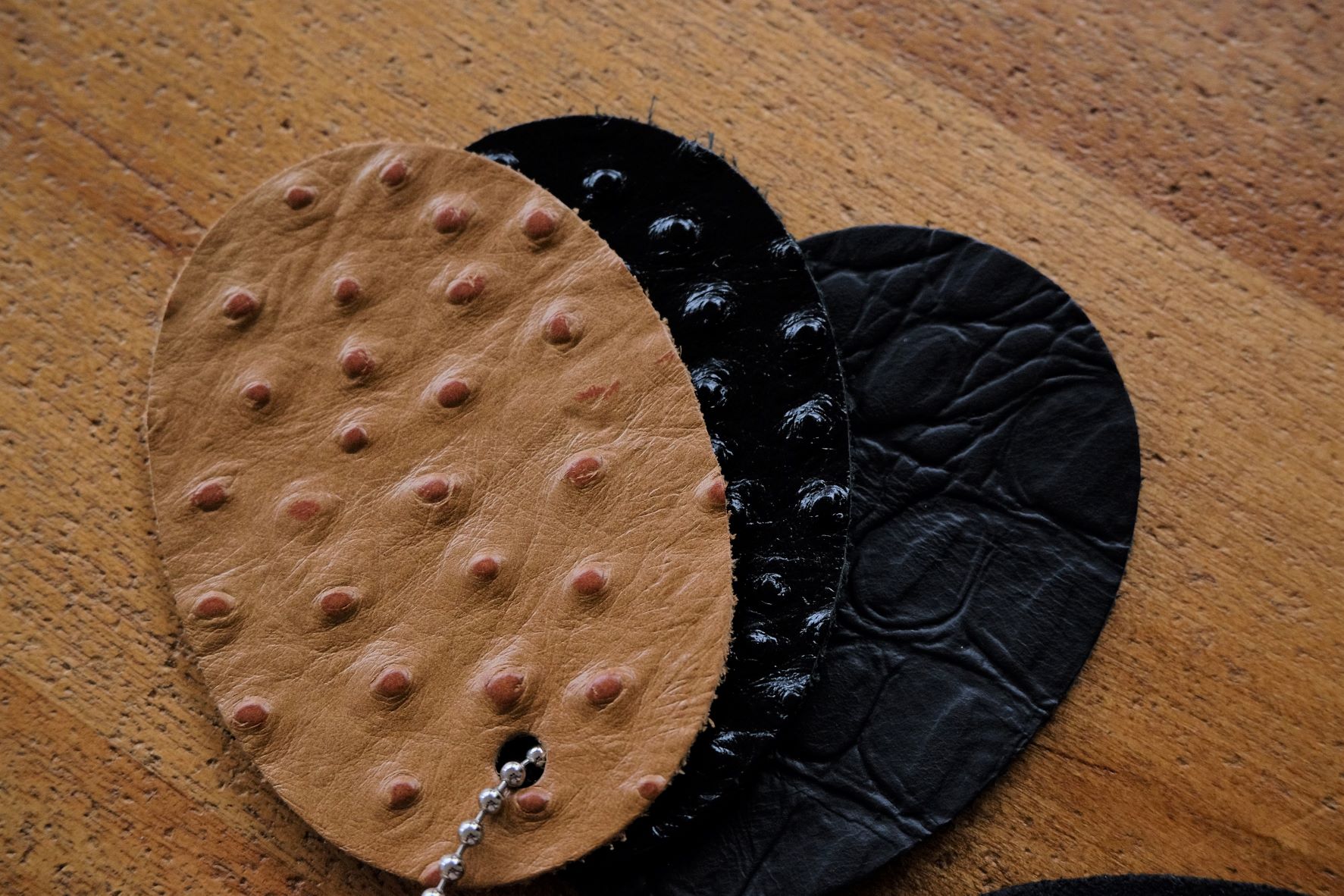
A few of Katzkin’s unique accent options. We have samples of all our options in both our locations.
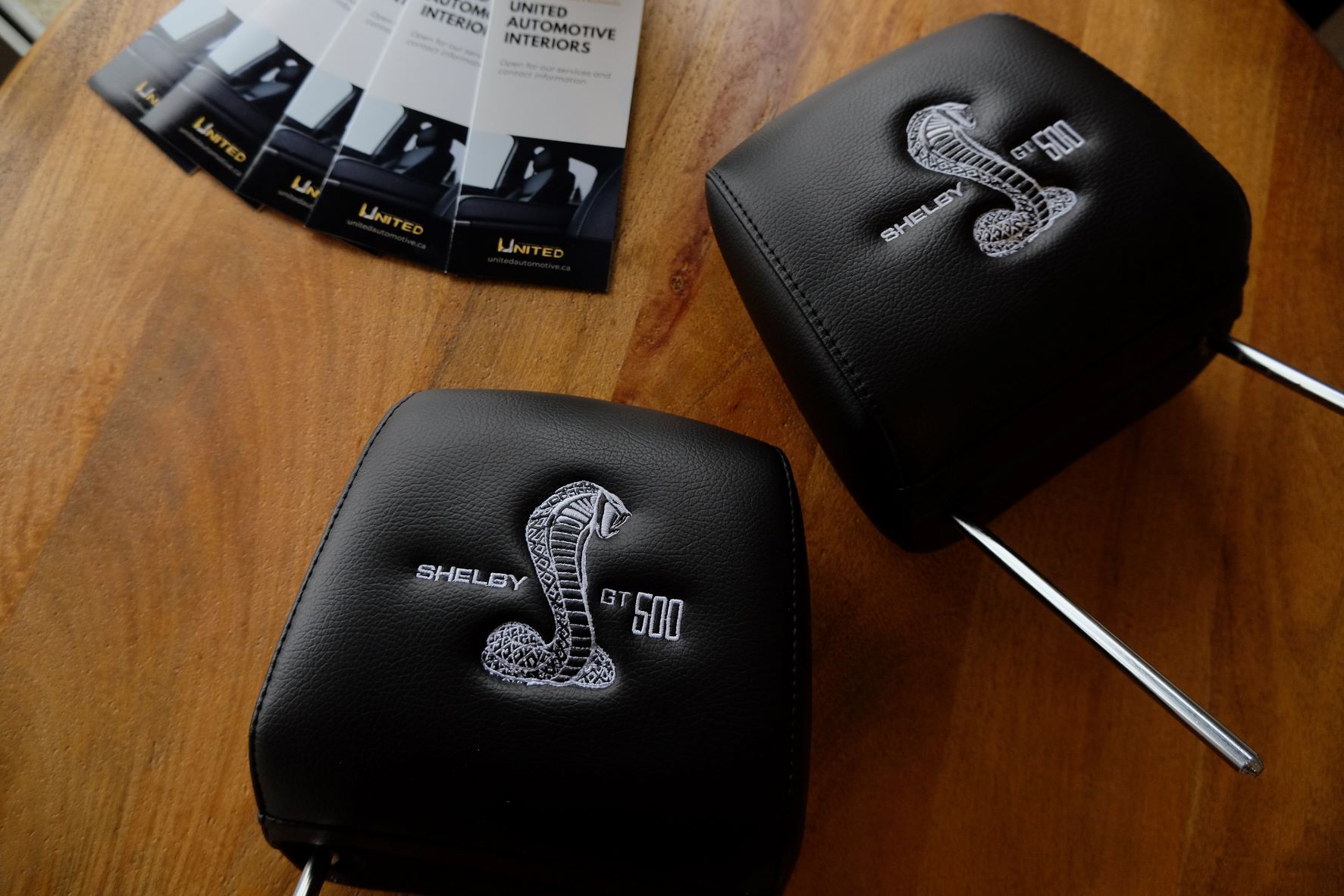
Custom embroidered headrests, we can embroidery anything as long as a quality png file is provided to us.
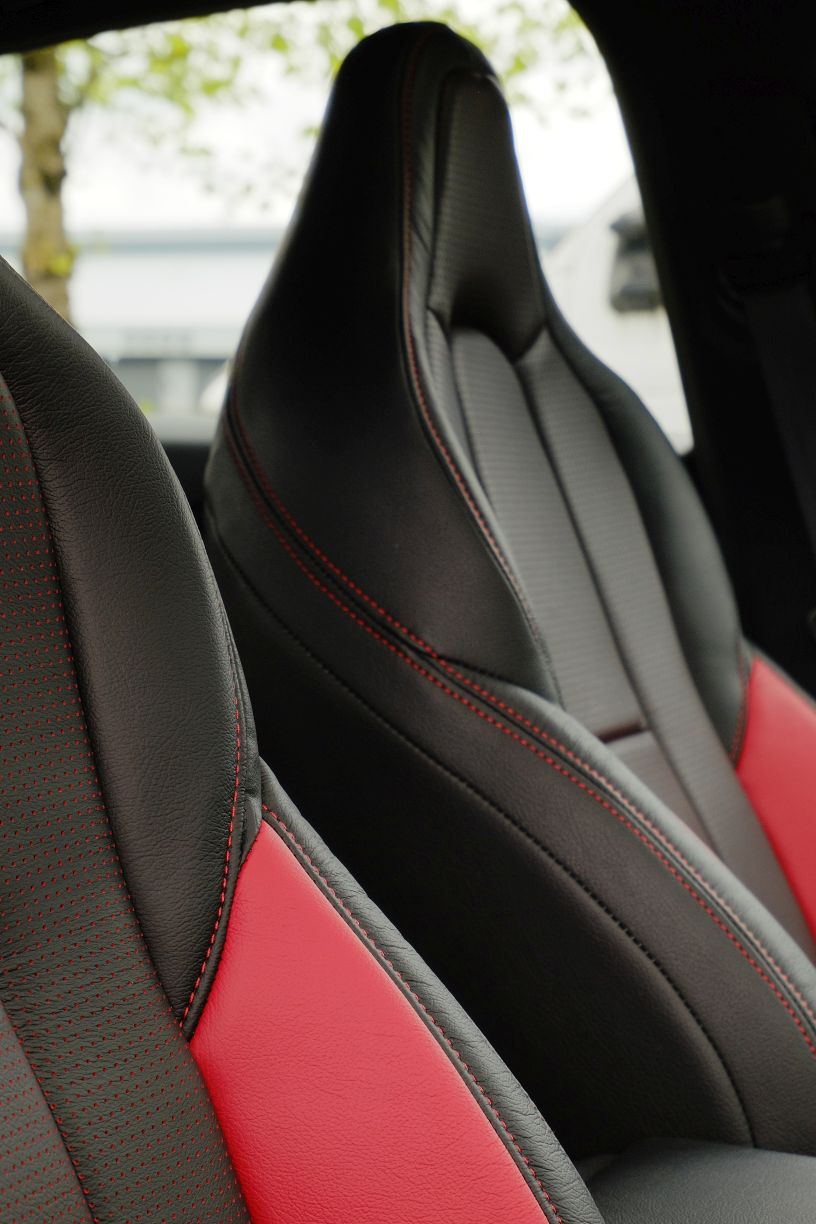
Custom leather installation in a 2022 Honda Civic. Each vehicle has a different sewing pattern, and therefore a different design.
What Can I Customize?
The sky’s the limit… almost! We’ve already explained that you can customize almost anything with an in-house installation so I’m going to go through all the upholstery kit customization options here instead. Here at United Automotive, we offer an inclusive $250 customization upgrade that allows you to make several changes to your design, from perforation, leather colors, and stitching colors. In addition to this, you can also customize by adding piping, diamond stitching, and special accent materials like carbon fiber to your upholstery design for additional charges.
When you're choosing your leather seat design there are a few factors we recommend people take into account:
- Current Upholstery: What colors are in the door panels and center console? Matching these can help improve the overall cohesiveness of your interior while also making it look factory. For example, your vehicle’s door panels are black with orange stitching. Here we would recommend black leather and orange stitching.
- Heated/Ventilated Seats: Because the foam that comes with leather seats is thicker than cloth seats it affects the performance of your heated seats. For that reason, if you have or are interested in adding heated seats we recommend perforated leather inserts to help the heat move quickly and evenly. For ventilated seats, the leather requires both perforated inserts and reticulated foam.
- Anticipated Wear & Tear: We always ask about the main use of your vehicle when making an order. This helps us point customers towards the right type of leather for their needs. Work and off-roading vehicles require a thicker, more durable leather, whereas luxury vehicles are better suited to something soft.
- Resale Value: Although new leather alone increases the vehicle resale value, we also encourage people to choose designs that will look amazing for themselves and the next owner as well. The key factors here include matching the current interior and exterior.
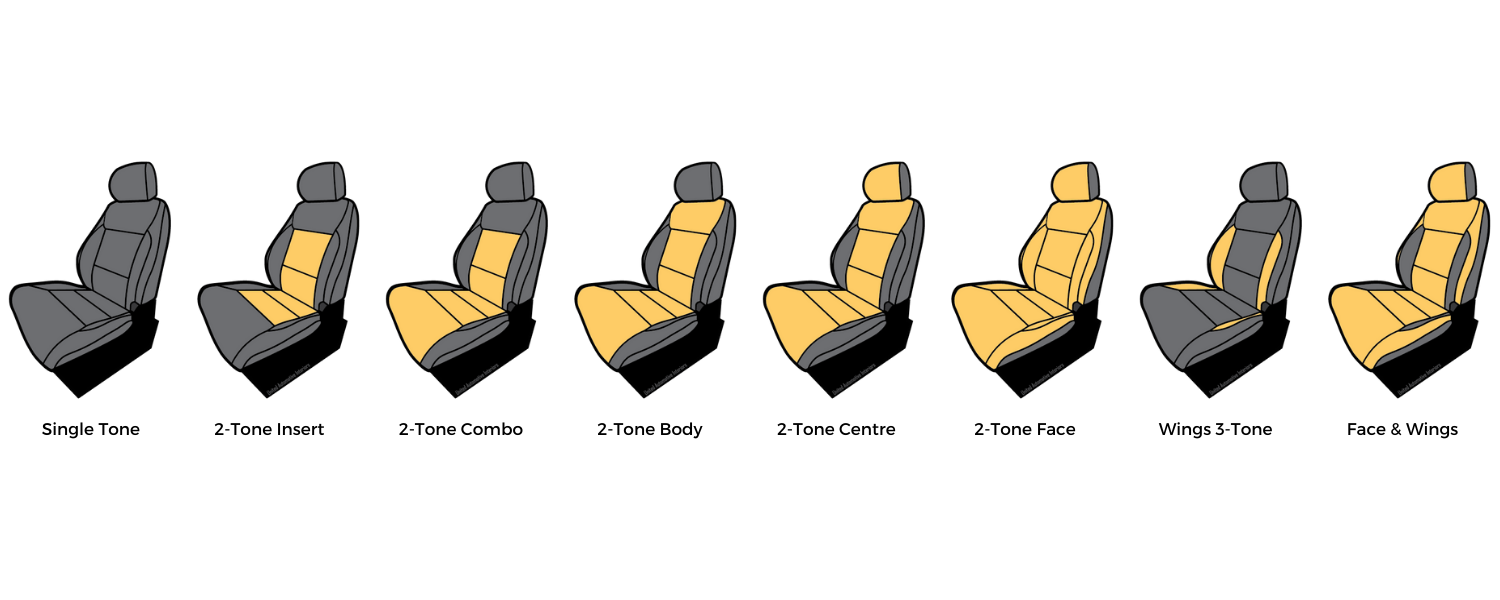
If you’re interested in custom upholstery there are a few design guidelines to consider. The examples below demonstrate the standard options for a 2-tone design, grey being your trim color and yellow as the placement option for an accent color. 3-tone designs consist of one of the four 2-tone options plus a third color in the ‘wings’. My personal favorite is a 2-tone face with wings the same color as the trim which creates stripes down the sides of the seats. (Seen in the far right example)
One of our suppliers, Katzkin, has this great ‘choose your design’ tool where you can play with the different options available for your vehicle. Or you can check out our gallery of previous jobs for some inspiration.
The second photo demonstrates what aftermarket automotive leather looks like when it’s simply pulled onto the seats, no heat, steam, or shaping. A completed installation should not look this wrinkly.
How is Aftermarket Leather Installed?
In our shop, our goal with every installation is to produce a final product that looks like it was installed by the manufacturer, or better. We do this by removing the seats from the vehicle, removing all the cloth, then we begin installing the leather upholstery. As we install the upholstery kit we use various heat tools to mold the leather to the contours of the foam to achieve a tight and wrinkle-free finish.
Watch one of our recent leather installations here:
How long do Aftermarket Leather Seats Last?
Our standard warranty covers you for 3 years/60,000 km of use, but we’ve had many customers who have had leather installed by us 7+ years ago and are coming to us with their next vehicle because they’re still so happy with the first installation.
Maintaining Leather To Last
When you have new leather installed in your vehicle, either from factory or aftermarket, it should come pristine with little to no wrinkles, and slightly matte. Over time you may notice that your leather will grow shinier where it sees wear, this is normal and nothing to worry about. Another thing that happens over time is drying, this is also normal, but definitely, something to be proactive about so it doesn’t become a concern 5-10 years in the future. Dry leather is difficult to repair, cracks easily, and can be uncomfortable to sit on which is why it’s important to properly maintain it!
Here are some of our best tips for leather maintenance from our team:
Keep your leather seats dry and out of direct sunlight.
This is the most important part of maintaining great-looking and feeling leather seats. Both sunlight and evaporating water affect the natural oils in the leather and speed up the aging and drying process.
When necessary, wash with a glycerin based cleaner.
Avoiding water-based cleaners is a simple way to avoid frequent contact with water. We offer a custom in-house mix to our customers, but you can find many alternatives available for purchase online.
For small spills, a barely damp cloth is alright in a pinch.
A tiny amount of water isn’t the end of the world! It’s frequent exposure that does damage, so if you gonna wipe up that streak of mud or spilled coffee don’t worry about it!
Condition your leather if you want it to last.
The best rule of thumb is every 2-3 months if your car is stored outside, and every 6 months for garage stored vehicles. The 2-3 month rule is especially important for convertibles!
Seeing multiple seat repairs from all makes and models come through our shop every day has taught us much about which vehicles have which kinds of ‘leather’ and what to watch out for. A common one is Toyota’s frequent use of fake leather. For a time they were describing their interiors as ‘leather accent’. More recently, they have branded their interiors as ‘Softex’ faux leather, the benefits of which seem to be argued for mostly by Toyota branded websites. Other companies, such as Mercedes Benz, do a better job of marketing and installing leather, though their designs also come with some flaws that cause their seats to regularly come through our shop for repairs.
A few final cleaning tips:
Vacuum First
Vacuuming is the most simple way to clean leather without harming it. It also removes any grit and grime before wiping it down which helps prevent scratching the leather. Make sure your vacuum attachment doesn’t scratch the leather (soft brush attachments are recommended.)
Wipe down the leather
If you don’t have a leather cleaner a barely damp cloth will work here. Otherwise, a good leather cleaner is great to use here.
For more intense spot cleaning:
there’s this great guide that goes into more detail: https://www.theartofcleanliness.com/automotive/leather-cleaning-care-guide/
Here are some more resources if you’re interested in learning more about cleaning leather:
Carl Friedrik: What happens when leather gets wet and how to fix it: https://www.carlfriedrik.com/blogs/magazine/wet-leather-guide
True Car Advisor: Do’s and Don’ts of Leather Car Seat Cleaning: https://www.truecar.com/blog/dos-donts-leather-car-seat-cleaning/
The Chemical Guys: How to clean dirty leather interior (Video) https://www.youtube.com/watch?v=IUyUw_Nkuvo
The Chemical Guys: How to revive and maintain leather: https://www.youtube.com/watch?v=MdKbmmO9hEQ
Complete References:
BMW Group, “Revolution, not evolution”, Sep 2021.
Car and Driver, “Tesla Vegan Leather”, June 2019.
Carl Friedrik, “What happens when leather gets wet and how to fix it”, 2018.
Harpers Bazaar, “Is vegan leather worse for the environment than real leather?” Apr 2020.
Insider, “What is Genuine Leather”, Jan 20, 2016.
Mochni, “Vegan Leather vs. Biodegradable Leather: Which Is The Winner?”, July 2017.
Popov Leather, “The Ultimate Guide to Leather Grades”, Oct 2019.
Sailrite, “Faux Leather: Better Than Real?” December 2019.
The Art of Cleanliness, “Ultimate Guide To Leather Cleaning and Care”, Jan 2021.
True Car, “Do’s and Don’ts of Leather Car Seat Cleaning”, Mar 2019.
The Chemical Guys, “How to clean dirty leather interior” (Video), Mar 2018.
The Chemical Guys, “How to revive and maintain leather” (Video), May 2017.
The Good Trade, “Is Vegan Leather A More Sustainable Option? The Answer Is Complicated.” Aug 2019.

